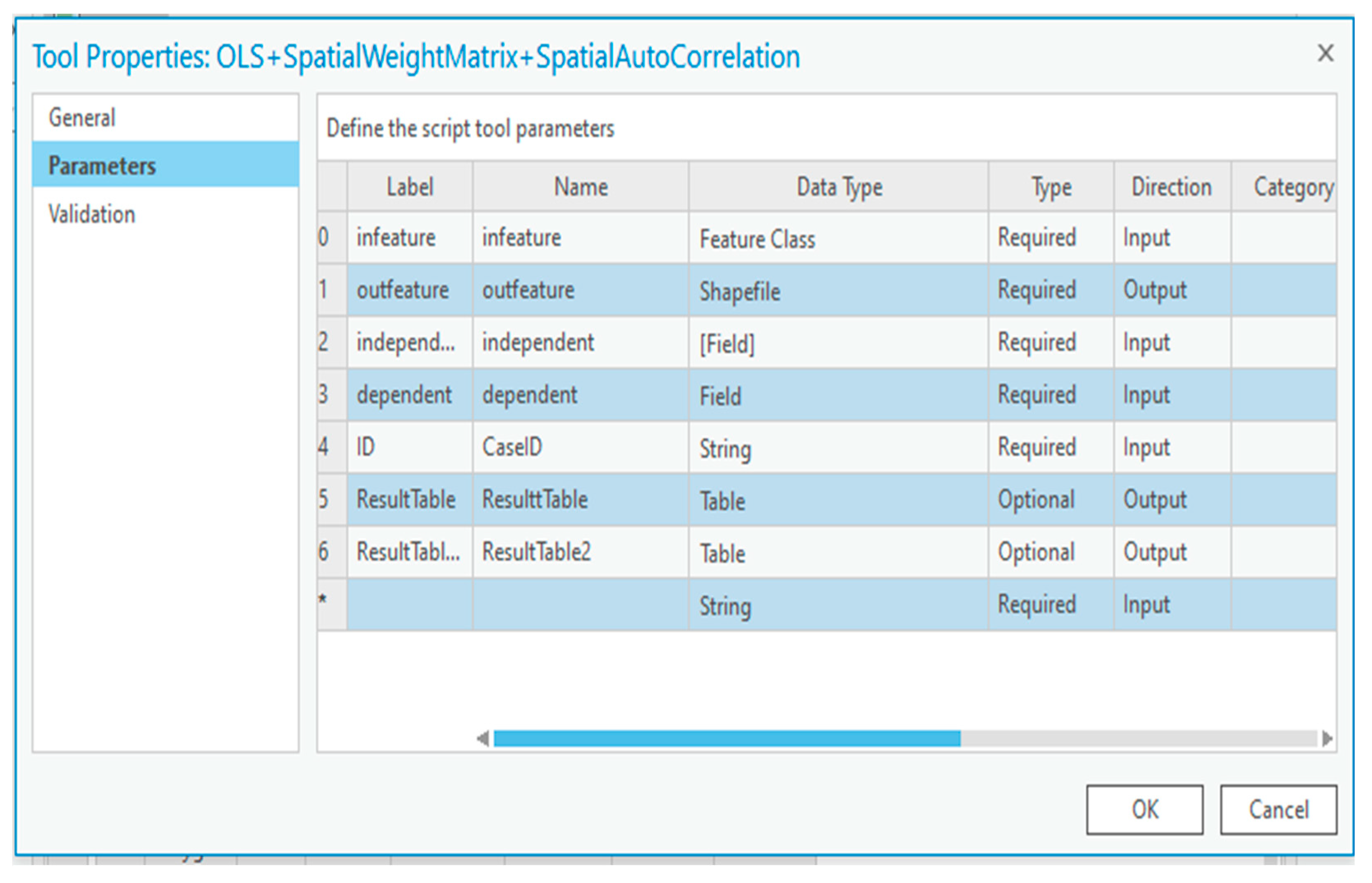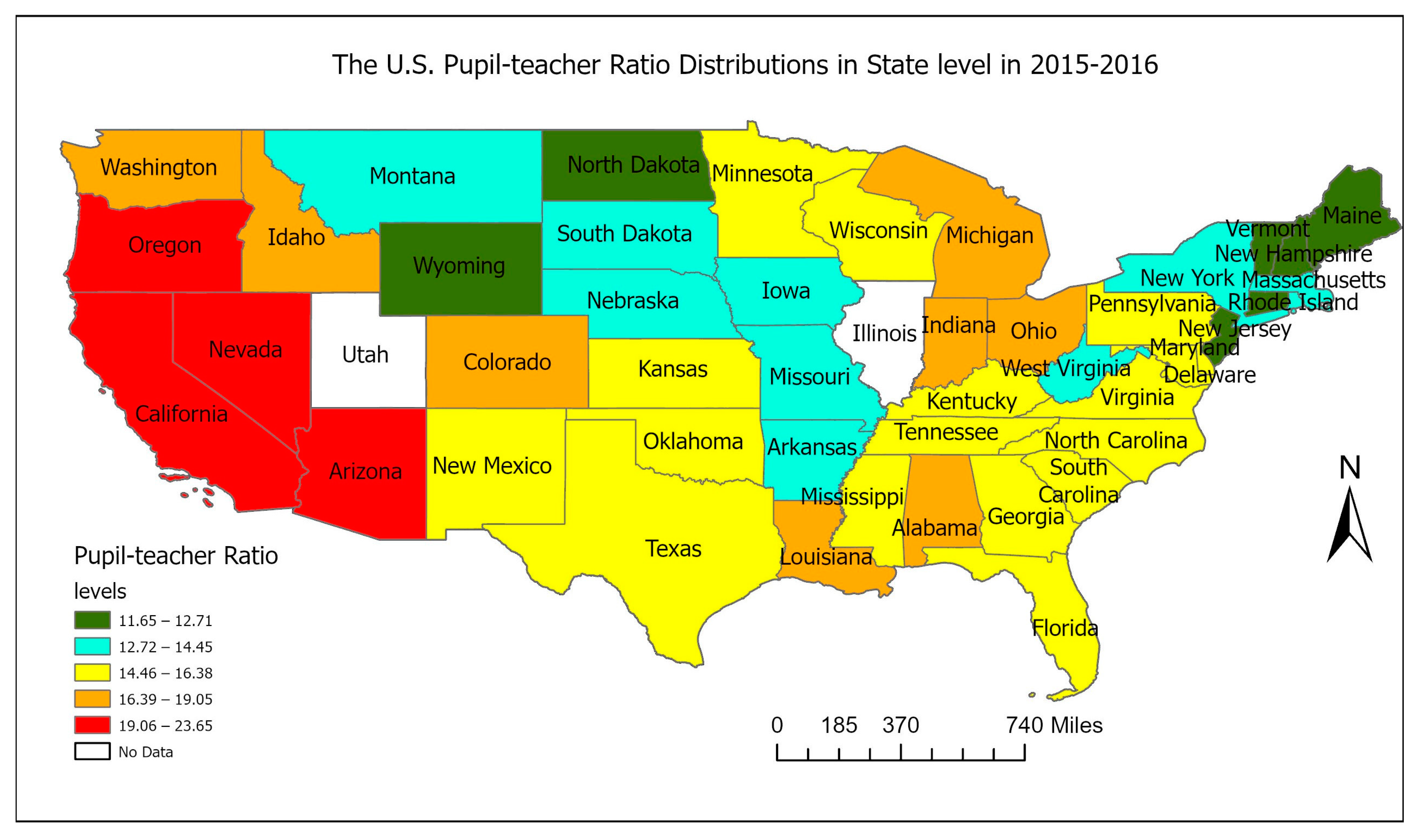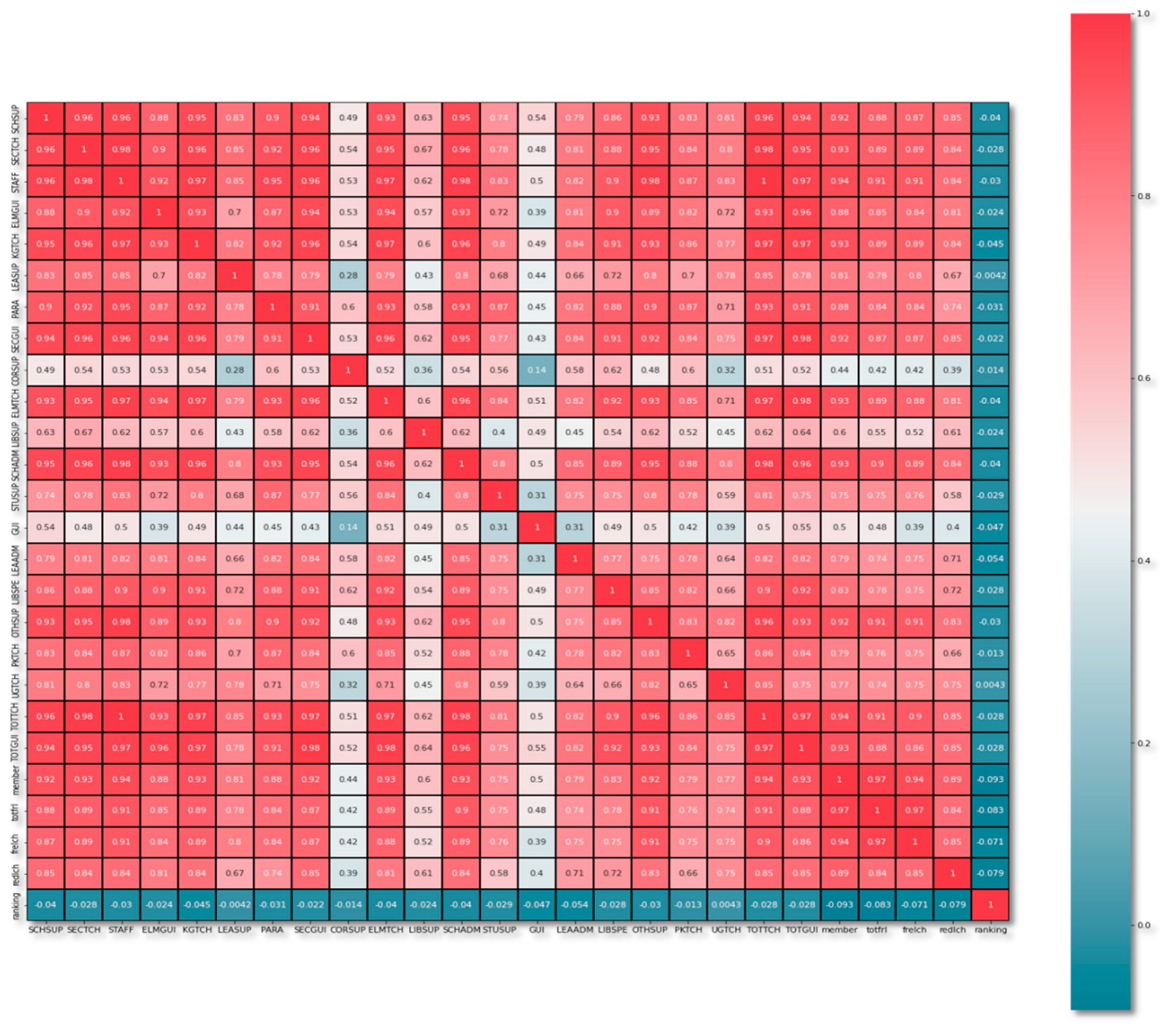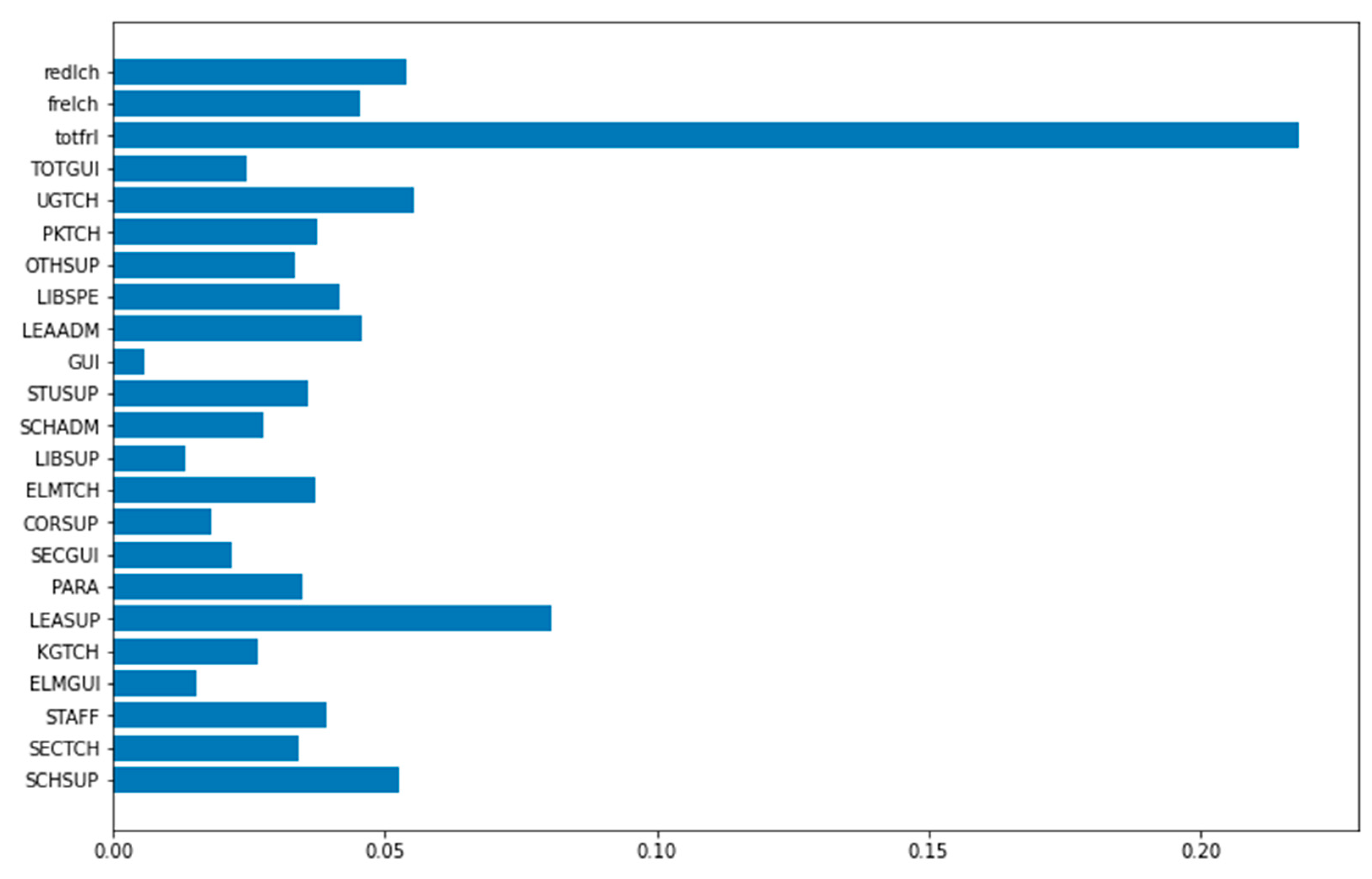Multi-Scale Toolbox: An Automated ArcGIS Tool for Evaluating Pupil–Teacher Ratios in U.S. Public School Districts
Abstract
1. Introduction
2. Materials and Methods
2.1. Data
2.2. Study Area
2.3. Study Framework
2.4. The Toolbox Design Procedure
- Module 1—the Join and Summarize tool
- Define parameters and standardized variables
- Table To Geodatabase (CCD table to local geodatabase)
- Define fields for summing aggregated data
- Statistics (State and County tables derived from district CCD data)
- AddField (Student Teacher Ratio in State and County Tables)
- Calculate Field (Student Teacher Ratio from Sum_Student and Sum_Teacher at State
- and County Levels)
- Feature Class To Feature Class (geometry shapefiles to geodatabase)
- Add Fields (Adjust joining fields-define specific field types)
- Join (CCD State and County Tables to geometry feature classes
- Module 2—the spatial OLS tool
- Ordinary Least Squares_stats (Cleaned CCD data table)
- Geographically Weighted Regression_stats (Cleaned CCD data table)
- Spatial Weight Matrix (Cleaned CCD data table)
- Autocorrelation Function (OLS Function out table)
- Module 3—the sensitive analysis tool
- Define parameters as text
- Create pandas data frame as cursor
- Define seaborn heatmap output visual characteristics
- Define input as cursor
- Save heatmap output
- Module 4—the random forest modelling tool
- Define parameters as text
- Run Random Forest Classifier
- Run Decision Tree Classifier
- Run train_test_split
- Run permutation_importance
- Run Random Forest Regressor
3. Case Study
3.1. Multiscale Visualization
3.2. The OLS/GWR Tool Results
3.3. Heatmap Sensitivity Analysis Results
3.4. Results of Modelling Random Forest Tree
4. Discussion
5. Conclusions
Author Contributions
Funding
Institutional Review Board Statement
Informed Consent Statement
Data Availability Statement
Acknowledgments
Conflicts of Interest
References
- Sutcher, L.; Darling-Hammond, L.; Carver-Thomas, D. Understanding teacher shortages: An analysis of teacher supply and demand in the United States. Educ. Policy Anal. Arch. 2019, 27, 35. [Google Scholar] [CrossRef]
- Carothers, D.; Aydin, H.; Houdyshell, M. Teacher shortages and cultural mismatch: District and university collaboration for recruiting. J. Soc. Stud. Educ. Res. 2019, 10, 39–63. [Google Scholar]
- García, E.; Weiss, E.; Economic Policy Institute. Examining the Factors That Play a Role in the Teacher Shortage Crisis: Key Findings from EPI’s “Perfect Storm in the Teacher Labor Market” Series; Economic Policy Institute: Palo Alto, CA, USA, 2020. [Google Scholar]
- Learning Policy Institute. The Role of Principals in Addressing Teacher Shortages. Research Brief; Learning Policy Institute: Palo Alto, CA, USA, 2017. [Google Scholar]
- Clark, M.A.; Isenberg, E.; Liu, A.Y.; Makowsky, L.; Zukiewicz, M. Impacts of the Teach for America Investing in Innovation Scale-Up. Revised Final Report; Mathematica Policy Research: Princeton, NJ, USA, 2017. [Google Scholar]
- Hof, J.; Bevers, M. Spatial Optimization for Managed Ecosystems; Columbia University Press: New York, NY, USA, 2000. [Google Scholar]
- Carver-Thomas, D. Teacher Shortages Take Center Stage; Learning Policy Institute: Palo Alto, CA, USA, 2022; Available online: https://learningpolicyinstitute.org/blog/teacher-shortages-take-center-stage (accessed on 7 November 2022).
- Garcia, E.; Weiss, E. The Teacher Shortage is Real, Large and Growing, and Worse than We Thought; Learning Policy Institute: Palo Alto, CA, USA, 2019; Available online: https://www.epi.org/publication/the-teacher-shortage-is-real-large-and-growing-and-worse-thanwe-thought-the-first-report-in-the-perfect-storm-in-the-teacher-labor-market-series/ (accessed on 7 November 2022).
- Clark, W.A.V.; Avery, K.L. The Effects of Data Aggregation in Statistical Analysis. Geogr. Anal. 1976, 8, 428–438. [Google Scholar] [CrossRef]
- Fotheringham, A.S.; Wong, D.W.S. The Modifiable Areal Unit Problem in Multivariate Statistical Analysis. Environ. Plan. A Econ. Space 1991, 23, 1025–1044. [Google Scholar] [CrossRef]
- Lewit, E.; Baker, L.S. Class size. Future Child. 1997, 7, 112–121. [Google Scholar] [CrossRef]
- Peers, C. Class Size and Pupil-Teacher Ratios: Where Education and Economics Collide; Information Age Publishing: Charlotte, NC, USA, 2016. [Google Scholar]
- Jensen, M.T. Pupil-teacher ratio, disciplinary problems, classroom emotional climate, and turnover intention: Evidence from a randomized control trial. Teach. Teach. Educ. 2021, 105, 103415. [Google Scholar] [CrossRef]
- Solheim, O.J.; Opheim, V. Beyond class size reduction: Towards more flexible ways of implementing a reduced pupil–teacher ratio. Int. J. Educ. Res. 2019, 96, 146–153. [Google Scholar] [CrossRef]
- Wang, M.-T.; Eccles, J.S. Retracted: Multilevel Predictors of Math Classroom Climate: A Comparison Study of Student and Teacher Perceptions. J. Res. Adolesc. 2016, 26, 617–634. [Google Scholar] [CrossRef]
- Waasdorp, T.E.; Pas, E.T.; O’Brennan, L.M.; Bradshaw, C.P. A Multilevel Perspective on the Climate of Bullying: Discrepancies among Students, School Staff, and Parents. J. Sch. Violence 2011, 10, 115–132. [Google Scholar] [CrossRef]
- Finn, J.D.; Fish, R.M.; Scott, L.A. Educational Sequelae of High School Misbehavior. J. Educ. Res. 2008, 101, 259–274. [Google Scholar] [CrossRef]
- Jensen, M.T. Are test-based policies in the schools associated with burnout and bullying? A study of direct and indirect associations with pupil-teacher ratio as a moderator. Teach. Teach. Educ. 2022, 113, 103670. [Google Scholar] [CrossRef]
- Borman, G.D.; Dowling, N.M. Teacher Attrition and Retention: A Meta-Analytic and Narrative Review of the Research. Rev. Educ. Res. 2008, 78, 367–409. [Google Scholar] [CrossRef]
- Jensen, M.T.; Solheim, O.J. Exploring associations between supervisory support, teacher burnout and classroom emotional climate: The moderating role of pupil teacher ratio. Educ. Psychol. 2019, 40, 367–388. [Google Scholar] [CrossRef]
- Maroulis, S.; Guimerà, R.; Petry, H.; Stringer, M.J.; Gomez, L.M.; Amaral, L.A.N.; Wilensky, U. Complex Systems View of Educational Policy Research. Science 2010, 330, 38–39. [Google Scholar] [CrossRef]
- Han, X.; Huwan, T. The Modular Design of an English Pronunciation Level Evaluation System Based on Machine Learning. Secur. Commun. Netw. 2022, 2022, 1–11. [Google Scholar] [CrossRef]
- Jung, A. Machine Learning: The Basics; Springer: Berlin/Heidelberg, Germany, 2022. [Google Scholar]
- Amin, M.N.; Iqbal, M.; Ashfaq, M.; Salami, B.A.; Khan, K.; Faraz, M.I.; Alabdullah, A.A.; Jalal, F.E. Prediction of Strength and CBR Characteristics of Chemically Stabilized Coal Gangue: ANN and Random Forest Tree Approach. Materials 2022, 15, 4330. [Google Scholar] [CrossRef]
- Jun, M.-J. A comparison of a gradient boosting decision tree, random forests, and artificial neural networks to model urban land use changes: The case of the Seoul metropolitan area. Int. J. Geogr. Inf. Sci. 2021, 35, 2149–2167. [Google Scholar] [CrossRef]
- Shah, M.; Lone, M.A. Flood Modeling and Simulation Using HEC-HMS/HEC-GeoHMS and GIS Tools for River Sindh-NW Himalayas. KN—J. Cartogr. Geogr. Inf. 2022, 1, 1–9. [Google Scholar] [CrossRef]
- Khatri, S.; Kokane, P.; Kumar, V.; Pawar, S. Prediction of waterlogged zones under heavy rainfall conditions using machine learning and GIS tools: A case study of Mumbai. GeoJournal 2022, 1, 1–15. [Google Scholar] [CrossRef]
- Shen, D.; Dong, S. Transition of Urban Morphology in the Mountainous Areas Since Early-Modern Times from the Perspective of Urban Historic Landscape—A GIS Tools and Historical Map Translation Approach. Sustainability 2022, 14, 12896. [Google Scholar] [CrossRef]
- Dawidowicz, A.; Dudzińska, M. The Potential of GIS Tools for Diagnosing the SFS of Multi-Family Housing towards Friendly Cities—A Case Study of the EU Member State of Poland. Sustainability 2022, 14, 6642. [Google Scholar] [CrossRef]
- Tamiru, H.; Wagari, M. Comparison of ANN model and GIS tools for delineation of groundwater potential zones, Fincha Catchment, Abay Basin, Ethiopia. Geocarto Int. 2021, 37, 6736–6754. [Google Scholar] [CrossRef]
- Fartas, N.; El Fellah, B.; Mastere, M.; Benzougagh, B.; El Brahimi, M. Potential Soil Erosion Modeled with RUSLE Approach and Geospatial Techniques (GIS Tools and Remote Sensing) in Oued Joumouaa Watershed (Western Prerif-Morocco). Iraqi Geol. J. 2022, 55, 47–61. [Google Scholar] [CrossRef]
- Vandergast, A.G.; Perry, W.M.; Lugo, R.V.; Hathaway, S.A. Genetic landscapes GIS Toolbox: Tools to map patterns of genetic divergence and diversity. Mol. Ecol. Resour. 2010, 11, 158–161. [Google Scholar] [CrossRef] [PubMed]
- Dobesova, Z. Visual Programming for Novice Programmers in Geoinformatics. Proc. Int. Multidiscip. Sci. GeoConference SGEM 2012, 3, 433–440. [Google Scholar] [CrossRef]
- Wu, X.; Zhang, J. Exploration of spatial-temporal varying impacts on COVID-19 cumulative case in Texas using geographically weighted regression (GWR). Environ. Sci. Pollut. Res. 2021, 28, 43732–43746. [Google Scholar] [CrossRef]
- Wu, X.; Denise, B.-B.; Zhan, F.; Zhang, J. Determining Association between Lung Cancer Mortality Worldwide and Risk Factors Using Fuzzy Inference Modeling and Random Forest Modeling. Int. J. Environ. Res. Public Health 2022, 19, 14161. [Google Scholar] [CrossRef]
- Brown, J.L.; Bennett, J.R.; French, C.M. SDMtoolbox 2.0: The next generation Python-based GIS toolkit for landscape genetic, biogeographic and species distribution model analyses. PeerJ 2017, 5, e4095. [Google Scholar] [CrossRef]
- Batelaan, O.; Zhong-Min, W.; De Smedt, F. An Adaptive GIS Toolbox for Hydrological Modelling; IAHS Publication: Washington, DC, USA, 1996; p. 235. [Google Scholar]
- Wanghe, K.; Guo, X.; Wang, M.; Zhuang, H.; Ahmad, S.; Khan, T.U.; Xiao, Y.; Luan, X.; Li, K. Gravity model toolbox: An automated and open-source ArcGIS tool to build and prioritize ecological corridors in urban landscapes. Glob. Ecol. Conserv. 2020, 22, e01012. [Google Scholar] [CrossRef]
- Marwedel, P. Embedded System Design: Embedded Systems Foundations of Cyber-Physical Systems, and the Internet of Things, 4th ed.; Springer: Berlin/Heidelberg, Germany, 2021. [Google Scholar]
- Deambi, S. Photovoltaic System Design: Procedures, Tools and Applications; CRC Press: Boca Raton, FL, USA, 2016. [Google Scholar]
- Dennis, A.; Wixom, B.H.; Roth, R.M. System Analysis and Design, 5th ed.; John Wiley: Hoboken, NJ, USA, 2012. [Google Scholar]
- How, A.I. Growth trends for selected occupations considered at risk from automation. Growth 2022, 2, 1–34. [Google Scholar]
- Zhang, P. Can public subsidy on education reduce wage inequality in the presence of automation? Ekon. Istraživanja 2022, 2, 1–17. [Google Scholar] [CrossRef]










| Category | No. | Variable Name | Variable Type | Variable Description |
|---|---|---|---|---|
| Dependent variable | 1 | Student-teacher ratio | Num | the number of students per teacher |
| Independent variables | 1 | SCHSUP | Num | School administrative support staff |
| 2 | SECTCH | Num | Teachers-Secondary | |
| 3 | STAFF | Num | Total staff FTE | |
| 4 | ELMGUI | Num | Guidance counselors/directors-Elementary | |
| 5 | KGTCH | Num | Teachers-Kindergarten | |
| 6 | LEASUP | Num | LEA Administrative support staff | |
| 7 | PARA | Num | Instructional aides/paraprofessionals | |
| 8 | SECGUI | Num | Guidance counselors/directors-Secondary | |
| 9 | CORSUP | Num | Instructional coordinators and supervisors | |
| 10 | ELMTCH | Num | Teachers-Elementary | |
| 11 | LIBSUP | Num | Librarians/media support staff | |
| 12 | SCHADM | Num | School administrators | |
| 13 | STUSUP | Num | Student support services staff | |
| 14 | GUI | Num | Guidance counselors/directors-Other | |
| 15 | LEAADM | Num | Local education agency (LEA) administrators | |
| 16 | LIBSPE | Num | Librarians/media specialists | |
| 17 | OTHSUP | Num | All other support services staff | |
| 18 | PKTCH | Num | Teachers-Prekindergarten | |
| 19 | UGTCH | Num | Teachers-Ungraded | |
| 20 | TOTGUI | Num | Guidance counselors/directors-Total | |
| 21 | TOTFRL | Num | total eligible free lunch | |
| 22 | FRELCH | Num | Current free lunch | |
| 23 | REDLCH | Num | Reduce free lunch |
Publisher’s Note: MDPI stays neutral with regard to jurisdictional claims in published maps and institutional affiliations. |
© 2022 by the authors. Licensee MDPI, Basel, Switzerland. This article is an open access article distributed under the terms and conditions of the Creative Commons Attribution (CC BY) license (https://creativecommons.org/licenses/by/4.0/).
Share and Cite
Wu, X.; Zhang, J.; Zhang, Y.; Zhang, D. Multi-Scale Toolbox: An Automated ArcGIS Tool for Evaluating Pupil–Teacher Ratios in U.S. Public School Districts. Appl. Sci. 2022, 12, 11449. https://doi.org/10.3390/app122211449
Wu X, Zhang J, Zhang Y, Zhang D. Multi-Scale Toolbox: An Automated ArcGIS Tool for Evaluating Pupil–Teacher Ratios in U.S. Public School Districts. Applied Sciences. 2022; 12(22):11449. https://doi.org/10.3390/app122211449
Chicago/Turabian StyleWu, Xiu, Jinting Zhang, Yaoxuan Zhang, and Daojun Zhang. 2022. "Multi-Scale Toolbox: An Automated ArcGIS Tool for Evaluating Pupil–Teacher Ratios in U.S. Public School Districts" Applied Sciences 12, no. 22: 11449. https://doi.org/10.3390/app122211449
APA StyleWu, X., Zhang, J., Zhang, Y., & Zhang, D. (2022). Multi-Scale Toolbox: An Automated ArcGIS Tool for Evaluating Pupil–Teacher Ratios in U.S. Public School Districts. Applied Sciences, 12(22), 11449. https://doi.org/10.3390/app122211449







